- 1Discipline of Clinical Pharmacy, School of Pharmaceutical Sciences, University Science Malaysia, Georgetown, Malaysia
- 2Department of Pharmacy, Penang Hospital, Ministry of Health, George, Town, Malaysia
- 3Department of Pharmacy, School of Applied Science, University of Huddersfield, Huddersfield, United Kingdom
- 4Department of Medicine, Penang Hospital, Ministry of Health, Georgetown, Malaysia
- 5Department of Optometry, College of Applied Medical Sciences, King Saud University, Riyadh, Saudi Arabia
- 6Department of Clinical Pharmacy, College of Pharmacy, King Saud University, Riyadh, Saudi Arabia
Introduction: Multidrug-resistant (MDR) microorganisms have increased all over the world, which is considered a public health threat. The emergence of MDR bacterial pathogens correlates with the increased antibiotic usage. This study aimed to determine the correlation between antibiotic usage and antibiotic resistance within 3 years.
Method: This was a retrospective cross-sectional study reviewing the positive bacterial culture results and the total antibiotic usage in six hospitals in Penang for 3 years from January 2021 to December 2023 through a convenient sampling method.
Results: Every sample type has experienced a significant shift over the years. Most microorganisms from all samples significantly changed in distribution over time, except for Streptococcus pneumoniae, carbapenem-resistant Enterobacterales (CRE) Escherichia coli, and CRE Klebsiella pneumoniae. However, methicillin-resistant Staphylococcus aureus (MRSA), K. pneumoniae, and Pseudomonas aeruginosa showed significant changes in the number of total isolates from blood cultures only in the 3 years. In terms of prevalence, statistically significant differences were observed for most microorganisms from all samples except for S. pneumoniae, CRE E. coli, and CRE K. pneumoniae across the years. P. aeruginosa showed significant prevalence in blood culture over time. Cefoperazone/sulbactam, amoxicillin/clavulanic acid, ceftriaxone, and ceftazidime showed significant changes in susceptibility for K. pneumoniae over time. A statistically significant difference in total antibiotic usage across the 3 years was observed. Regarding the correlation between antibiotic usage and antibiotic resistance, Pearson’s correlation was 0.777 (p = 0.433), which is suggestive of a strong positive correlation between third-generation cephalosporin usage and extended-spectrum beta-lactamase (ESBL), whereas Pearson’s correlation was 0.762 (p = 0.448), which also suggests strong positive correlation between carbapenem usage and CREs.
Conclusion: The correlation between the use of third-generation cephalosporins and ESBL rate, as well as the use of carbapenems and CRE rate, further suggests that controlling certain antibiotic usage could help mitigate the rise in MDR microorganisms.
Introduction
Multidrug-resistant (MDR) microorganisms have increased all over the world, which is considered a public health threat. Several recent investigations have reported the emergence of multidrug-resistant bacterial pathogens from different origins, increasing the necessity of the judicious use of antibiotics, in addition to the routine application of antimicrobial susceptibility testing to detect the appropriate antibiotic of choice, as well as the screening of the emerging MDR strains. Antimicrobial resistance occurs when microbes like bacteria and fungi develop mechanisms to withstand the effects of drugs designed to kill them. Infections caused by resistant bacteria can be difficult, and sometimes impossible, to treat. Antimicrobial resistance is a naturally occurring process. However, increases in antimicrobial resistance are driven by a combination of microbes exposed to antibiotics and antifungals and the spread of those microbes and their resistance mechanisms. Alarmingly, antimicrobial-resistant germs can share their resistance mechanisms with other microbes that have not been exposed to antibiotics or antifungals. Antibiotic-resistant strains originating from animals can also be disseminated to humans through the food supply, by direct contact with the animals, or through environmental routes (Lhermie et al., 2016; Qureshi et al., 2024; Shami et al., 2024). In addition, several researchers have suggested an association between antimicrobial usage and the presence of antimicrobial-resistant strains found not only in livestock but also in human-to-human transmission (Sharma et al., 2017). A study conducted in slaughterhouses has revealed that all Pseudomonas aeruginosa isolates were MDR, most of them have multiple resistant genes, including the blaCTX-M gene, and some strains have the ability to form biofilms and have virulence genes (Al-Kadmy et al., 2024). Alarmingly, a similar study on birds from various geographical areas found extensive drug-resistant (XDR) P. aeruginosa carrying multiple virulence-related genes (Algammal et al., 2023). A study in Egypt reported the isolation of Staphylococcus aureus from diseased ducks at a prevalence of >10% (Eid et al., 2019). An Escherichia coli strain was isolated in China and found to carry multiple resistance genes that exhibit resistance to almost all clinically used antibiotics (Shafiq et al., 2022).
The World Health Organization (WHO) reported that globally, in 2019, approximately 4.95 million people who died suffered from drug-resistant infections. Antimicrobial resistance (AMR) directly caused 1.27 million of those deaths. The number of deaths attributed to AMR in Malaysia is higher than deaths from digestive diseases, diabetes and kidney diseases, transport injuries, chronic respiratory diseases, and neurological disorders. There are five pathogens to be aware of in Malaysia (number of deaths associated with AMR in parentheses): Streptococcus pneumoniae (3,200, 33%), E. coli (2,100, 21%), Acinetobacter baumannii (1,900, 20%), Klebsiella pneumoniae (1,400, 14%), and S. aureus (1,200, 12%) (National Antibiotic Resistance Surveillance Report 2023). Antimicrobial resistance in Malaysia continues to escalate and is attributed to the overuse and misuse of antibiotics, including those that can be purchased over the counter. The Malaysian government has come up with an action plan to create public awareness regarding the health implications of antibiotic resistance (Naeemmudeen et al., 2021). Another study from Malaysia had revealed the correlation between 3-year trends of antibiotic consumption [defined daily dose (DDD)/100 admissions] with MDR infection cases (per 100 admissions). The antimicrobial resistance trend demonstrated a positive correlation between extended-spectrum cephalosporins and fluoroquinolones towards the development of resistant microorganisms (Tan et al., 2022).
A key component of antibiotic stewardship programs is the collection and dissemination of antibiotic resistance patterns or antibiograms for various microorganisms. In Malaysia, the antibiogram used is a numerical profile detailing the susceptibility of various microorganisms to multiple antibiotics cultured from patients (William et al., 2021). An antibiotic is deemed susceptible to a specific microorganism if it likely responds to treatment at standard dosing as per the European Committee on Antimicrobial Susceptibility Testing (EUCAST, 2022) recommendation. These data must be regularly updated to keep pace with the rapid emergence of resistant bacterial pathogens (Antibiotic resistance,World Health Organization, 2023). Insights from this study are expected to provide a framework for addressing antibiotic resistance and potentially lowering overall mortality rates. Alarmingly, the resistance rate to ciprofloxacin, used for uncomplicated urinary tract infections, varied significantly, from 8.4% to 92.9% for E. coli and from 4.1% to 79.4% for K. pneumoniae across countries reporting to the Global Antimicrobial Resistance and Use Surveillance System (GLASS) (Antibiotic resistance, World Health Organization, 2023). Therefore, the primary aim of this study was to assess the prevalence of antibiotic resistance across various wards and specimens to enhance understanding and provide suitable treatment regimens for patients.
Frequent monitoring of antibiotic usage is another recommended practice within antimicrobial stewardship programs, providing insights into usage trends. Such surveillance can highlight instances of any inappropriate use, which further necessitates further audits or interventions (Antibiotic resistance, World Health Organization, 2023). Antibiotic usage is typically measured in terms of DDDs, which standardize comparisons globally. Each antibiotic is assigned an anatomical therapeutic chemical (ATC) code and a DDD value in grams (Antibiotic resistance,World Health Organization, 2016). The WHO advised expressing DDD per 100 bed-days in hospitals and per 1,000 patient-days (PD) to accurately reflect the exact usage (WHO, 2016). The DDD can be compared among hospitals or even across countries, with those exceeding the upper limit (DDD + SD) considered high users, potentially requiring additional audits (Antibiotic resistance, World Health Organization, 2023).
Numerous studies have indicated that antibiotic usage significantly influences the prevalence of antibiotic resistance (Shapiro et al., 2020). For instance, Abdul Aziz et al. (2023) reported a 17% reduction in the mean DDD per 1,000 patient-days for antibiotics targeted by antimicrobial stewardship (AMS) programs, decreasing from 161.52 to 134.49 DDD. This reduction was primarily attributed to the decreased use of third-generation cephalosporins, carbapenems, and colistin. These findings strongly suggest that antibiotic usage directly impacts the prevalence of antibiotic resistance.
The main objective of this study was to determine the correlation between antibiotic usage across various pharmacological classes and antibiotic resistance prevalence and patterns (antibiogram) in hospitals in Penang.
Methods
Study design and population
This was a retrospective cross-sectional study reviewing the positive bacterial culture results from various sources and the total antibiotic usage in terms of grams or units in hospitals in Penang for 3 years from January 2021 to December 2023. A convenient sampling method was used in this study, which means that only positive bacterial culture results were included. The required data for all the positive isolates (identified microorganisms) and antibiotic usage from January 2021 to December 2023 were obtained accordingly for research purposes. The study end-point was to determine the minimum inhibitory concentration (MIC) for each pathogen against the corresponding antibiotics and classify accordingly as susceptible, intermediate, or resistant.
Study settings
This study was conducted in six general hospitals in the state of Penang, Malaysia. These hospitals have the capacity to serve a population of 1.77 million, as revealed by the Department of Statistics Malaysia. This facility provides almost all the sub-specialty services for the entire northern region of Peninsular Malaysia.
Inclusion and exclusion criteria
All the first positive bacterial isolates from 1 January 2021 to 31 December 2023 were included. The samples were collected from inpatients only from all wards with more than 48 hours of admission. Only one sample per patient (applicable if the same patient had >1 positive sample) was counted in this study. Varieties of biological samples were included in this study such as blood culture, cerebrospinal fluid (CSF) culture, and other body fluid cultures such as from drains and bile, pus swab culture, high vaginal swab (HVS) culture, sputum (SPT) culture, urine culture, bone and joint aspirate culture, pus fluid culture, tissue culture, and stool culture. However, those with incomplete bacterial resistance data (e.g. unidentifiable microorganism due to gross contamination) were excluded from this study.
The calculation of total antibiotic usage in terms of DDD from 1 January 2021 to 31 December 2023 was included. The DDDs were collected from inpatients only from all wards and for intravenous antibiotics only.
Data collection
The data were extracted from the integrated computerized system. The sample size was determined using the simple formula by Daniel (1999) with a 95% confidence interval, Z value of 1.96, expected prevalence of carbapenem-resistant Enterobacterales (CREs) and extended-spectrum beta-lactamase (ESBL) at Hospital Pulau Pinang (Chuah H. C., 2019) of 0.2%, and precision of 5%. Hence, the minimum sample size required was 285 according to the formula adapted from Daniel (1999). The methods of bacterial identification adopted were Gram staining and culture-based identification, whereby the bacteria were grown on suitable media. The colony morphology, colour changes, and haemolysis patterns (on blood agar) help in preliminary identification. The antimicrobial susceptibility testing methods used were the MIC and disk diffusion method as recommended by the EUCAST 2022. Molecular method using polymerase chain reaction (PCR) was adopted to detect genes associated with antibiotic resistance, resulting in ESBL and CREs. XDR was defined as a microorganism resistant to at least one antibiotic in all but two or fewer antibiotic classes, including beta-lactams, aminoglycosides, and fluoroquinolones. The microorganism was classified as MDR if it was resistant to at least one agent in three or more antibiotic classes. CREs were defined as microorganisms resistant to carbapenem antibiotics, which were further confirmed via PCR to detect the genes responsible for the mutations (mostly NDM or OXA-48). ESBL was measured via disk diffusion or MIC testing method for antimicrobial susceptibility testing using third-generation cephalosporins + clavulanic acid.
However, the sample size for the antibiotic usage was determined using the simple formula of finite population correction considering a large population size of 1.77 million with 95% confidence interval, Z value of 1.96, standard deviation of DDD/1,000 PD (Lee et al., 2018) of ± 55.5, and margin of error of 5%. Hence, the sample size required was 473 prescriptions (Daniel, 1999). The usage of antibiotics was recorded by the respective pharmacists stationed at multiple pharmacy satellites based on the supply of antibiotics as per the inpatient prescription.
Ethical board approval from the Medical Research Ethics Committee (MREC) and the Ministry of Health (MOH) was obtained prior to the initiation of this study. The approval number given was NMRR ID-23-00308-SB6.
Statistical analysis
Statistical evaluation was performed using IBM SPSS version 22 (SPSS Inc., Chicago, IL, USA), with a 95% confidence interval (CI) calculated accordingly, and a p-value of less than 0.05 was considered significant. For the antibiotic resistance-related analysis, descriptive analysis was performed in this study using Pearson’s chi-square (χ2) test. However, the prevalence was calculated using the Comprev® software version 3.0.31. The formula for prevalence calculation was the number of existing cases divided by the total population with similar cases and then multiplied by 100 to yield the percentage.
For the antibiotic usage analysis, descriptive analysis was performed in this study using Friedman’s test, considering that the data were not normally distributed, and a non-parametric equivalent of repeated-measures ANOVA. The DDD was calculated by total antibiotic usage in grams divided by the DDD given by the WHO. It was further divided into the number of patient-days for that particular year (obtained from the respective admission office) and then multiplied by 1,000.
The correlation or association between antibiotic usage and the prevalence of ESBL and CREs was determined using Pearson’s and Spearman’s correlation tests. A linear regression test was also performed to further explain the correlation.
Results
The prevalence and antibiotic susceptibility patterns (antibiogram)
This study was aimed primarily to determine the correlation between antibiotic usage and antibiotic resistance pattern, commonly known as antibiogram, within 3 years. The proposed hypothesis was that there is a significant association between the two variables, which means that increased DDD of the respective antibiotic class would consequently result in increased resistance capability of the associated bacterial pathogens. Therefore, this study merged the data obtained from the microbiology and pharmacy units for the antibiogram and DDD data, respectively, to further evaluate the correlation.
Table 1 summarizes the data for each sample type across the 3 years, showing both the number of samples and their respective percentages. All p-values were below 0.05, meaning that every sample type experienced a significant shift over the years. The changes in distribution were statistically significant for each culture type.
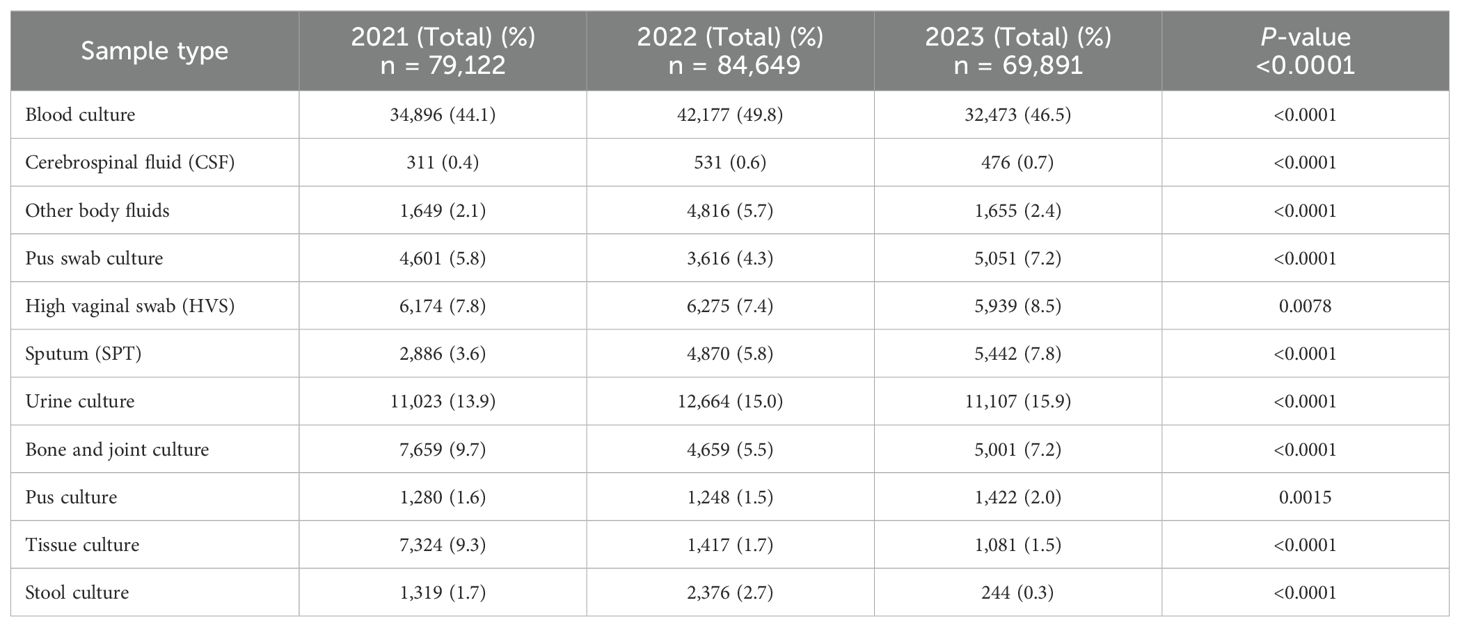
Table 1. The total number and types of culture samples accepted for culture and sensitivity (C&S) in Penang for the years 2021, 2022, and 2023.
Table 2 shows the total number of isolates for various types of microorganisms (from all samples) for 3 years in Penang. Most microorganisms mentioned above significantly changed in distribution over time. S. pneumoniae, CRE E. coli, and CRE K. pneumoniae did not show a significant change. Otherwise, resistance trends like methicillin-resistant S. aureus (MRSA), ESBL, and MDR strains showed major shifts.
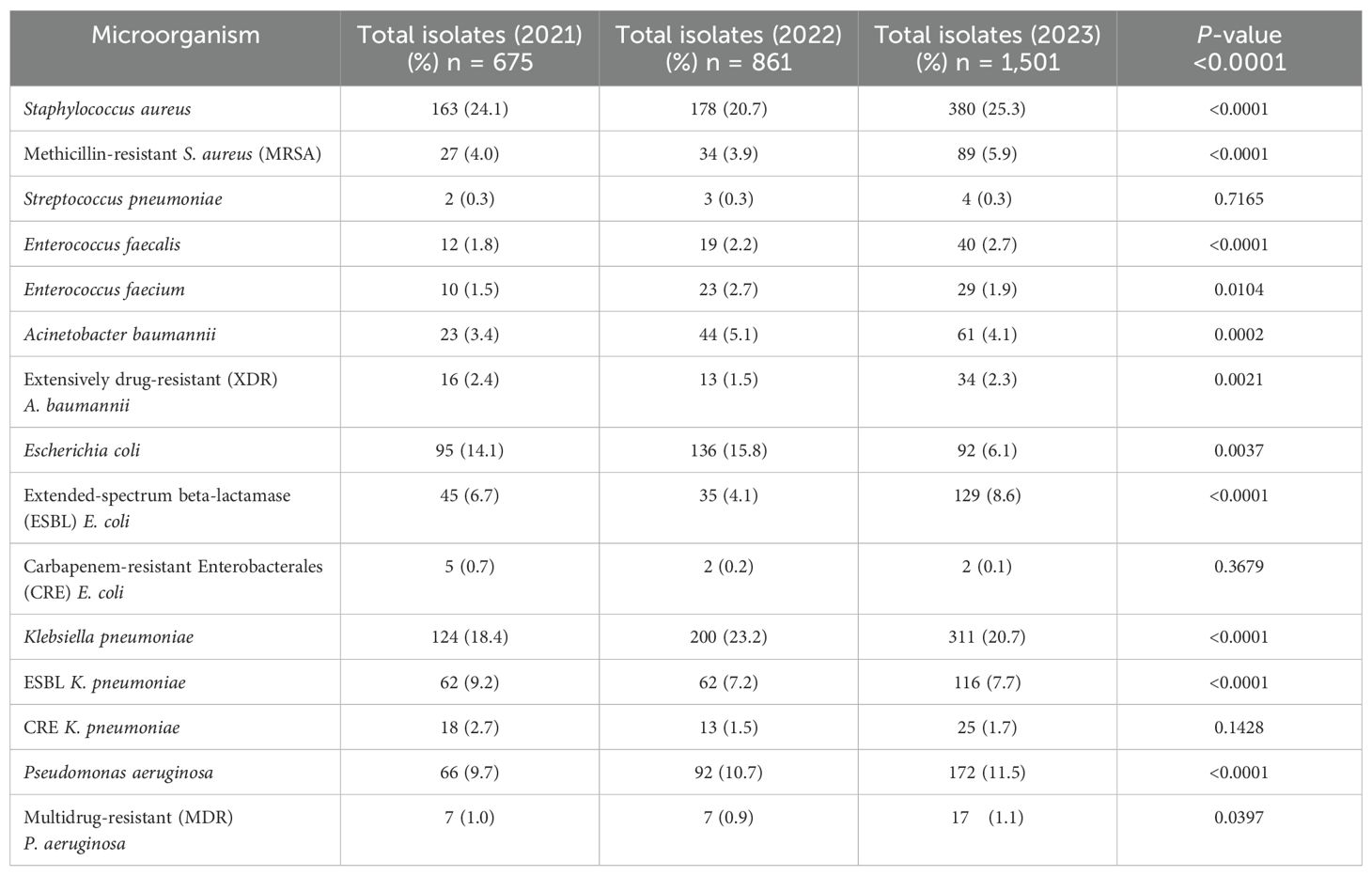
Table 2. The total number of isolates for various types of microorganisms (from all samples) obtained in Penang for the years 2021, 2022, and 2023.
Table 3 shows the number of bacterial isolates from blood cultures only for each bacterial species across the years 2021, 2022, and 2023. Three microorganisms, namely, MRSA, K. pneumoniae, and P. aeruginosa, showed significant changes in the number of total isolates in the 3 years.
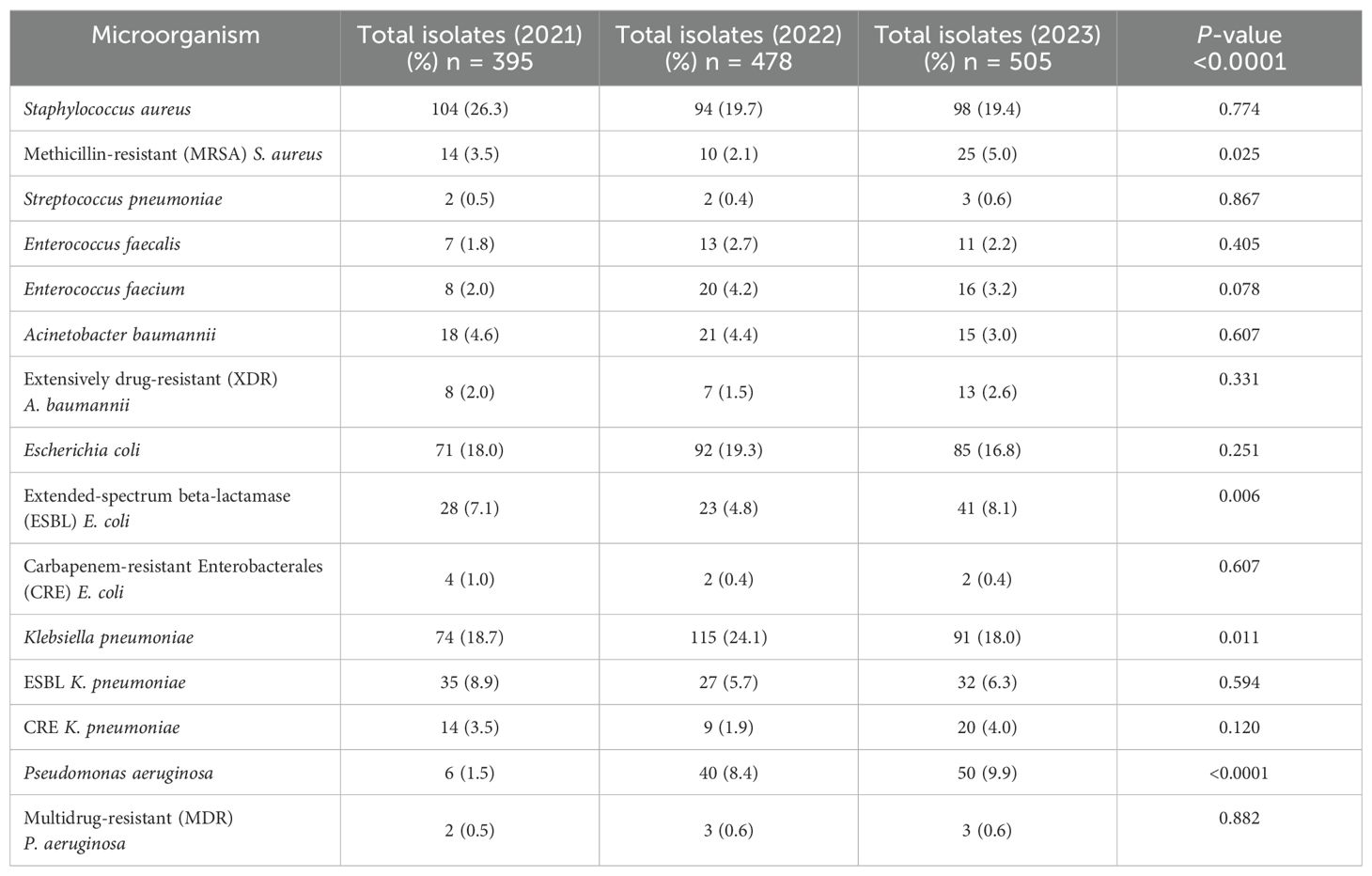
Table 3. The total number of isolates for various types of microorganisms (from blood culture only) obtained in Penang for the years 2021, 2022, and 2023.
The most common types of Gram-positive microorganisms isolated were S. aureus, MRSA, S. pneumoniae, Enterococcus faecalis, and Enterococcus faecium. Table 4 depicts the prevalence of various microorganisms from all samples obtained in Penang for 3 years. Statistically significant differences were observed for most microorganisms, except for S. pneumoniae, carbapenem-resistant Enterobacterales E. coli, and carbapenem-resistant Enterobacterales K. pneumoniae across the study span of 3 years. Table 5 shows the prevalence of multiple microorganisms from blood culture only in the 3 years. P. aeruginosa is the most concerning, showing a statistically significant rise over time.
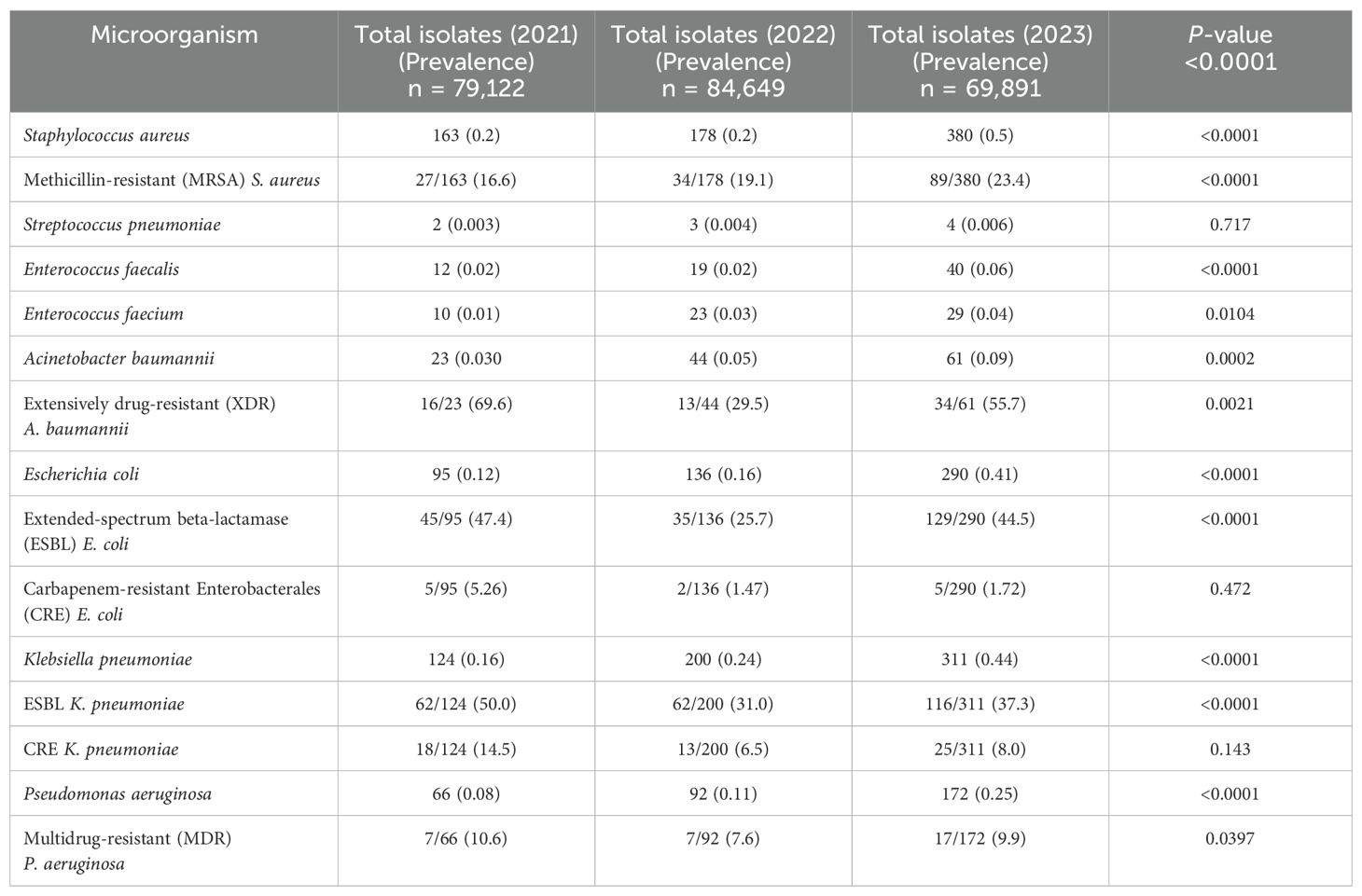
Table 4. The prevalence of various types of microorganisms (from all samples) obtained in Penang for the years 2021, 2022, and 2023.
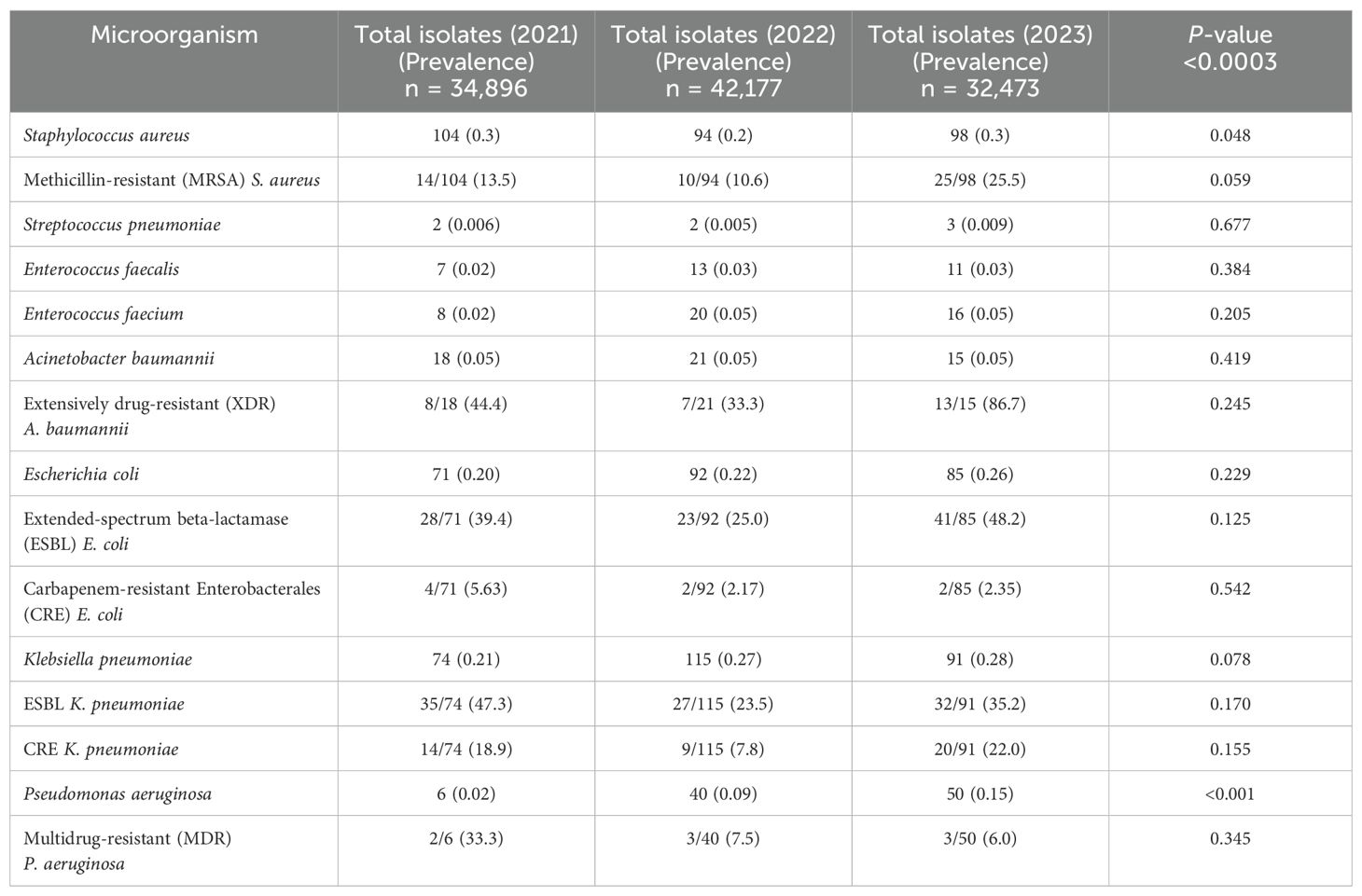
Table 5. The prevalence of various types of microorganisms (from blood culture only) obtained in Penang for the years 2021, 2022, and 2023.
Tables 6 and 7 illustrate further the various types of Gram-positive and Gram-negative microorganisms, respectively, across the years. Almost all the microorganisms showed no difference in terms of significant antibiotic susceptibility, except for K. pneumoniae, which had significant changes in susceptibility over the years, especially for cefoperazone/sulbactam, amoxicillin/clavulanic acid, ceftriaxone, and ceftazidime.
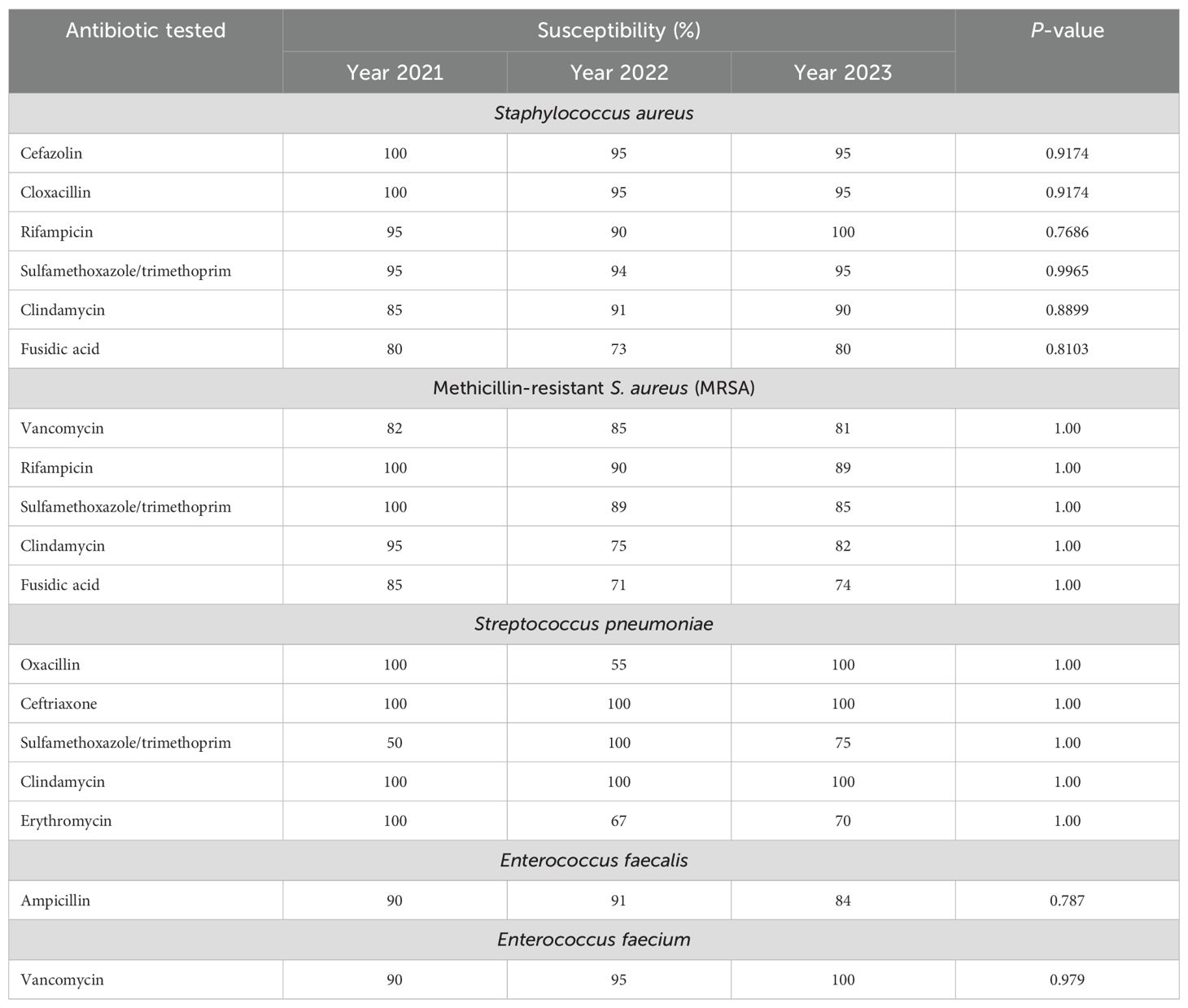
Table 6. Antibiogram table for Gram-positive microorganisms obtained in Penang from year 2021 to year 2023.
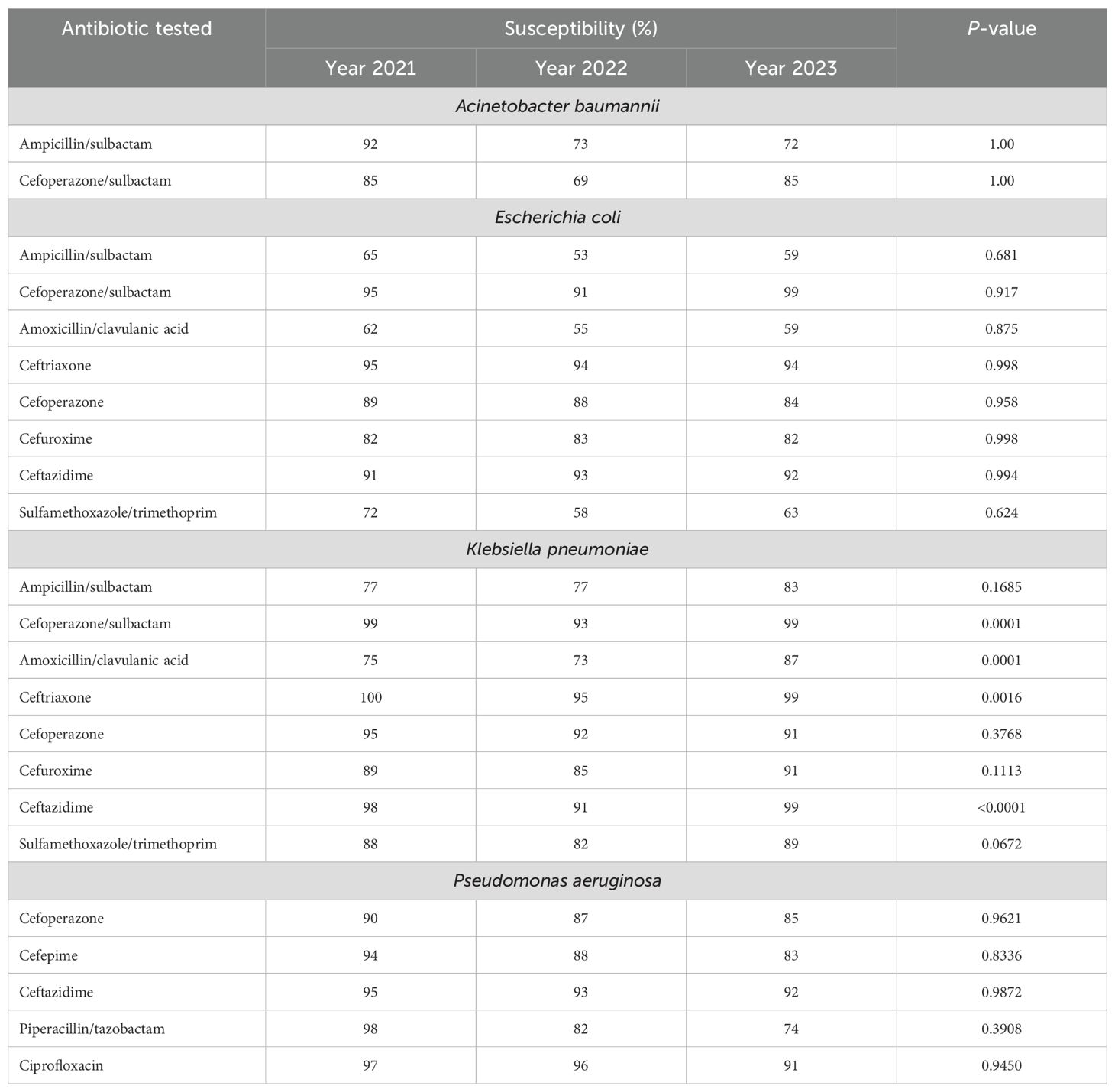
Table 7. Antibiogram table for Gram-negative microorganisms obtained in Penang from year 2021 to year 2023.
Total defined daily dose for the total antibiotics used
This study presents the trends in the use of various antibiotics, as measured by DDDs per 1,000 PD, over 3 years (2021–2023). The data reveal notable variations in the usage of certain antibiotic classes and specific drugs, which could reflect changes in clinical practice, resistance patterns, or hospital policies.
A total of 689 prescriptions within the study duration that met the inclusion and exclusion criteria were included in this study. The results in Table 8 showed a consistent increase in the usage of penicillins and cephalosporins, while other antibiotic classes such as carbapenems and fluoroquinolones demonstrated variable trends. The most obvious increment was observed in amoxicillin/clavulanic acid and ampicillin/sulbactam, both of which exhibited a steady rise in DDD per 1,000 PD from 2021 to 2023. Additionally, cephalosporins, particularly cefuroxime, ceftazidime, and ceftriaxone, showed a notable upward trend, with ceftriaxone increasing from 108.68 DDD/1,000 PD in 2021 to 131.50 DDD/1,000 PD in 2023.
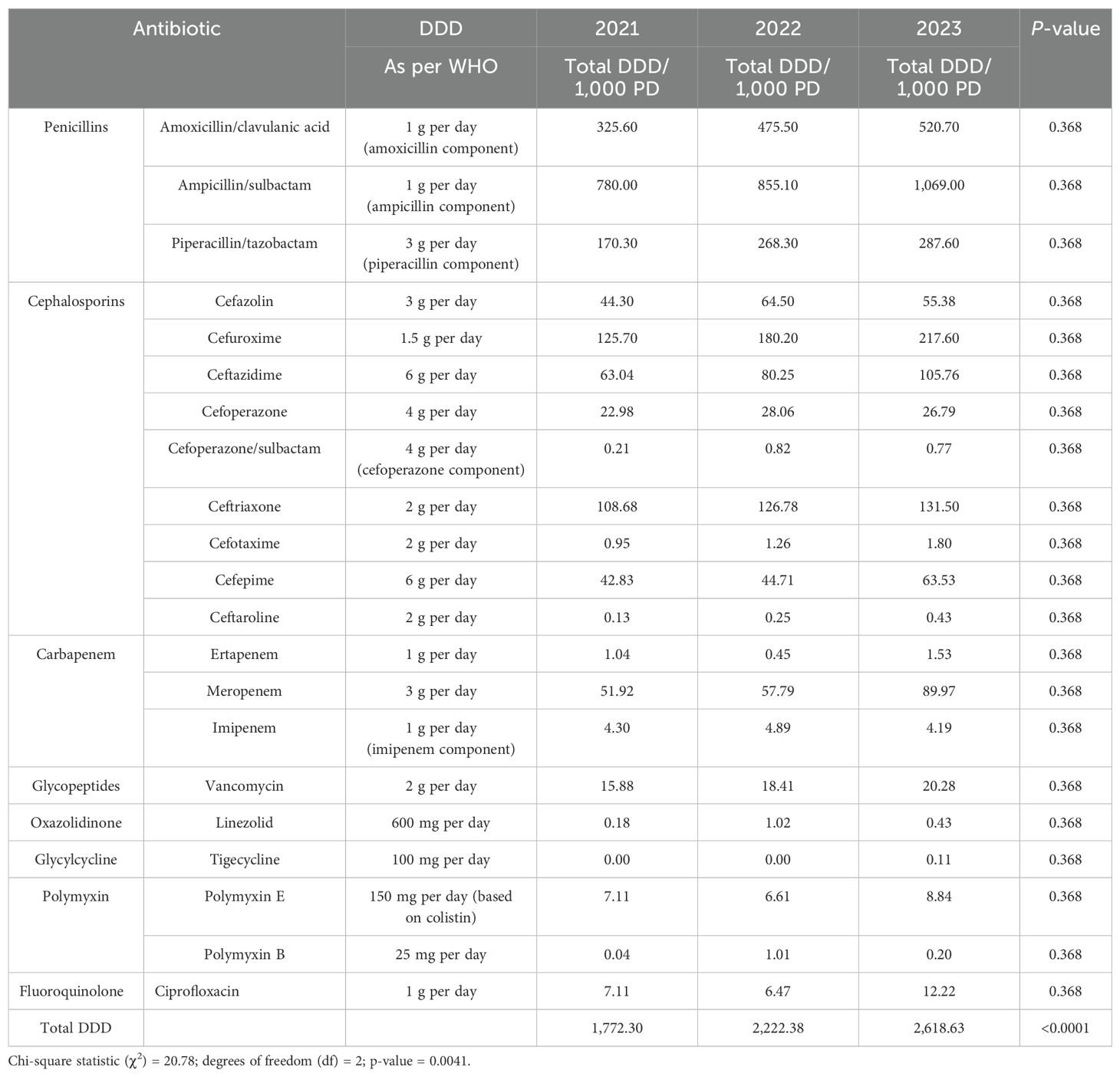
Table 8. Total defined daily dose (DDD)/1,000 patient-days (PD) for antibiotics used in hospitals in Penang for the years 2021, 2022, and 2023 (n = 689).
However, carbapenems showed mixed results. Meropenem usage increased substantially from 51.92 DDD/1,000 PD in 2021 to 89.97 DDD/1,000 PD in 2023. Conversely, ertapenem showed a decline in usage, with only slight fluctuations over the 3 years, a statistically significant difference in total antibiotic usage across the 3 years, which suggests that at least 1 year, it had a significantly different antibiotic consumption compared to the others [chi-square statistic (χ2) = 20.78; degrees of freedom (df) = 2; p-value = 0.0041]. However, there was no statistically significant difference in the usage of each type of antibiotic across the years 2021, 2022, and 2023.
Correlation between antibiotic usage and antibiotic resistance pattern
In terms of the correlation between total third-generation cephalosporin usage, including ceftazidime, cefoperazone, cefoperazone/sulbactam, ceftriaxone, and cefotaxime, and ESBL, Pearson’s correlation was 0.777, which suggests a strong positive correlation, but the p-value (0.433) indicated that the correlation was not statistically significant. Spearman’s correlation was 0.500, which suggests a moderate positive correlation, but again, the p-value (0.667) indicated a lack of statistical significance. However, the linear regression R2 value shows 0.604, which means that approximately 60.4% of the variation in ESBL cases can be explained by third-generation cephalosporin usage, although the p-value (0.433) was still not significant. Table 9 shows the correlation results across 3 years in Penang.

Table 9. Correlation between third-generation cephalosporin usage and prevalence of extended-spectrum beta-lactamase (ESBL)-producing Escherichia coli and Klebsiella pneumoniae in hospitals in Penang for the years 2021, 2022, and 2023.
Table 10 shows the correlation results between carbapenem usage and the prevalence of CREs across 3 years in Penang. Pearson’s correlation was 0.762, which suggests a strong positive correlation, but the p-value (0.448) indicated that the correlation was not statistically significant. Spearman’s correlation was 0.500, which suggests a moderate positive correlation, but again, the p-value (0.667) indicated a lack of statistical significance. However, the linear regression R2 value shows 0.581, which means that approximately 58.1% of the variation in CRE cases can be explained by carbapenem usage, although the p-value (0.537) was still not significant.

Table 10. Correlation between carbapenem usage and prevalence of carbapenem-resistant Enterobacterales (CRE) Escherichia coli and Klebsiella pneumoniae in hospitals in Penang for the years 2021, 2022, and 2023.
Discussion
This study investigated the prevalence of resistant bacterial isolates from all samples and blood cultures over a period of 3 years (2021–2023) in several hospitals. The results reveal significant findings regarding both the prevalence of bacterial isolates and antibiotic resistance patterns. These findings contribute to understanding the current state of all samples’ culture susceptibility in both Gram-positive and Gram-negative microorganisms in Penang.
Globally, the positivity rate of blood cultures in this study (12%–13%) was within the accepted range, aligning with findings from global studies, such as those by Kahlmeter et al. (2020), which reported positivity rates of 10%–14% in similar hospital settings. However, the issue of insufficient blood volume affecting positivity rates has been identified as a critical factor in improving diagnostic yield, as shown in quality assurance initiatives in the UK (Bookstaver et al., 2017). The steps being taken in the current study via a quality assurance project to improve blood collection methods could lead to better outcomes, as studies by Zhang et al. (2023) have suggested that increasing blood sample volumes significantly improves positivity rates.
The study found that the number of bacterial isolates has steadily increased, with the prevalence of microorganisms rising from all samples and blood culture only in 2021 to 2023, with p-values of p < 0.0001 and p < 0.0003, respectively. This upward trend is consistent with findings from other studies. For example, a study by Ahmed et al. (2022) in South Asia reported a similar rise in bacterial isolate prevalence over 5 years, which they attributed to the increasing use of antibiotics and the changing microbial landscape in hospitals. The increase in isolates in the present study can be linked to multiple factors, including improved diagnostic technologies and, perhaps, concerningly, the injudicious use of antibiotics, which could contribute to higher bacterial resistance rates (Vijayakumar et al., 2020). However, there is a possibility that the total number of bacterial isolates during the COVID-19 pandemic, compared to the previous years (e.g. 2018), showed significant fluctuations, which could be due to changes in healthcare practices, infection control measures, and antibiotic usage. Several studies have reported a decline in overall bacterial isolates from clinical samples, largely attributed to reduced hospital visits, widespread use of masks, social distancing, and improved hygiene practices, which limited the transmission of bacterial infections. A study in Finland observed a decrease in the prevalence of E. coli isolates in urinary tract and bloodstream infections during the pandemic (Ilmavitra et al., 2024).
Notably, the increasing prevalence of MRSA in this study is consistent with reports from other regions, such as the USA and Europe, where MRSA rates often range from 20% to 30% (Klein et al., 2020). The fact that all MRSA isolates were >80% sensitive to vancomycin is a positive sign, in contrast to studies indicating increasing vancomycin resistance in some regions, such as India, where vancomycin-resistant S. aureus (VRSA) has been reported at rates higher than 5% (Wu et al., 2021). Moreover, the gradual development of resistance to rifampicin and trimethoprim/sulfamethoxazole in MRSA isolates (10%–20%) noted in this study mirrors the findings of a similar study in the South Korea by Bae et al., (2023), who found a rising trend in rifampicin resistance in MRSA isolates, which poses a challenge for treatment, especially for oral treatments.
In terms of E. faecalis, this study found that its isolates are gradually becoming resistant to ampicillin, which is concerning. Similar trends have been observed globally, as shown by studies such as those by Daniel et al. (2015), who reported high resistance rates to ciprofloxacin among enterococci in Southeast Asia. The gradual resistance to ampicillin in E. faecalis in this study is also consistent with global patterns, where studies in the USA and Europe have noted a steady increase in ampicillin resistance over the past decade (Zhang et al., 2021).
The study’s findings on Gram-negative bacteria, particularly E. coli, A. baumannii, and P. aeruginosa, reflect a concerning rise in resistance rates. E. coli demonstrated resistance to ampicillin/sulbactam and amoxicillin/clavulanic acid, with an alarming rise in CREs. This aligns with global reports, such as those from the World Health Organization (2021), which have highlighted the increasing spread of CREs worldwide, particularly in healthcare settings. The high prevalence of carbapenem resistance in E. coli and K. pneumoniae strains found to be a growing concern due to the limited treatment options for such infections. A similar study in India noted that the prevalence of CREs has increased significantly over the past few years, echoing the findings in this study (Devi et al., 2024).
The finding that A. baumannii is acquiring resistance to ampicillin/sulbactam is also supported by international reports. Studies conducted in South Korea have reported that Acinetobacter baumanii strains are increasingly resistant to common beta-lactams, with XDR strains becoming more prevalent (Kang et al., 2024). The fact that A. baumannii remains sensitive to polymyxin B in this study is promising, but global surveillance has warned of the potential for polymyxin resistance emerging in the future, which could complicate treatment (Cai et al., 2012).
Similarly, P. aeruginosa remains sensitive to ceftazidime and ciprofloxacin, which is a positive finding, despite gradually developing resistance to cefepime and piperacillin/tazobactam (preferred options in this facility), as resistance in P. aeruginosa has been steadily rising worldwide, as per the recent report from Europe (Oliver et al., 2015).
In this study, the total DDD/1,000 PD for the antibiotics used revealed a significant difference across 3 years, which is parallel with numerous studies conducted worldwide (Zhong et al., 2021; Chuah et al., 2019). The increase in the DDD of amoxicillin/clavulanic acid and ampicillin/sulbactam may reflect an escalation in infections requiring broad-spectrum beta-lactamase inhibitors, possibly due to the increasing prevalence of beta-lactamase-producing organisms (Bookstaver et al., 2017). These findings align with global concerns about antibiotic resistance, where beta-lactamase inhibitors are often prescribed to combat resistant strains, including those producing ESBLs (Chambers and DeLeo, 2020).
However, the consistent rise in the use of cephalosporins, particularly cefuroxime, ceftazidime, and ceftriaxone, may indicate an increased clinical need for agents targeting a broad range of bacterial pathogens, including those associated with respiratory, intra-abdominal, and urinary tract infections (Wushouer et al., 2023). These findings suggest that hospitals may be adopting broader-spectrum cephalosporins as empirical therapy, likely due to changes in prescribing practices.
In contrast, the usage trends for carbapenems (notably meropenem) may signal an increased reliance on these agents as last-line therapies for ESBL organisms. The notable increase in meropenem use, specifically, could be due to rising cases of multidrug-resistant Gram-negative microorganisms like ESBL-producing E. coli and K. pneumoniae (Livermore, 2021). While ertapenem remained relatively stable with a slight decline, the increase in meropenem usage suggests a shift towards using carbapenems in more severe or resistant infections, possibly due to the inability of other antibiotics to treat these resistant strains (e.g. P. aeruginosa).
In a nutshell, the findings in this study are consistent with previous studies showing an increase in the use of broad-spectrum antibiotics, particularly in the context of antibiotic resistance. For example, an increase in the use of cephalosporins and penicillins with beta-lactamase inhibitors has been observed in other hospital settings, where empirical treatments often favour these agents to cover a wider range of pathogens (Paterson et al., 2022). The rise in the use of meropenem mirrors trends seen in global healthcare settings, where the growing prevalence of carbapenem-resistant organisms has led to an increased need for these last-line agents (Zhong et al., 2021).
The trends observed in this study regarding the correlation between antibiotic usage and antibiotic resistance rates align with those seen in other healthcare settings globally, where the antibiotic resistance rate has risen because of increased usage. It is parallel with findings in another recent study, which has also shown a growing reliance on broad-spectrum antibiotics, particularly beta-lactam and carbapenem-based therapies, due to the increasing prevalence of multidrug-resistant pathogens (Paterson et al., 2022). Studies have noted that ESBL-producing microorganisms are driving up the use of carbapenems and other broad-spectrum antibiotics in many healthcare settings (Livermore, 2021). The increase in the use of cephalosporins and penicillins with beta-lactamase inhibitors observed here is consistent with global trends indicating the escalating treatment costs associated with resistant infections (Klein et al., 2020).
The rise in antibiotic resistance is driven by multiple mechanisms, including the overuse and misuse of antibiotics in both healthcare and agriculture, leading to selective pressure for resistant strains (Livermore, 2021). Horizontal gene transfer (HGT), involving plasmids and transposons, facilitates the spread of resistance genes such as ESBL and carbapenemases among bacterial populations (Zhang et al., 2021). Additionally, bacterial mutations and biofilm formation contribute to increased resistance, particularly in hospital-acquired infections (Ahmed et al., 2022). The COVID-19 pandemic further exacerbated antibiotic resistance due to the widespread empirical use of antibiotics for suspected secondary bacterial infections, despite bacterial co-infection rates being less than 10% (Devi et al., 2022). Hospitals experienced disruptions in antimicrobial stewardship programs, leading to increased prescriptions of broad-spectrum antibiotics like carbapenems and fluoroquinolones, which likely contributed to rising rates of multidrug-resistant organisms (World Health Organization, 2021). Furthermore, prolonged hospital stays, increased ventilator use, and inadequate infection control during the pandemic created an environment conducive to the spread of resistant bacteria, including MRSA and CREs (Oliver et al., 2015). These findings highlight the urgent need for stronger antimicrobial stewardship programs and global surveillance to mitigate the escalating antibiotic resistance crisis.
Conclusion
The correlation between the use of third-generation cephalosporins and ESBL rate, as well as the use of carbapenems and CRE rate, further suggests that controlling certain antibiotic usage could help mitigate the rising AMR. The key findings of this study revealed a concerning gradual rise in resistant bacterial isolates in both Gram-positive and Gram-negative microorganisms. The increase in resistance, especially against commonly used antibiotics like penicillins and cephalosporins, highlights the growing challenge of managing infections, especially multidrug-resistant pathogens like ESBL and CREs. The study’s findings align with global trends, reinforcing the need for more effective strategies in combating AMR, particularly in healthcare settings.
Strengths and limitations
The study centres are among the main referral centres, especially in the northern region of Peninsular Malaysia, covering almost all the major sub-specialties and thus being considered the major strength of this study. On top of that, another added advantage is that there are three in-house infectious disease consultants, comparable to other tertiary care centres worldwide. Another strength of the study is the large number of samples pooled from the six general hospitals.
While the data presented here offer valuable insights, there are several limitations that should be considered. The study is limited by the lack of detailed patient demographic information, including the diagnosis and antibiotic history, which could further inform the contextual factors influencing the antibiotic resistance patterns.
Not only that, but the study is also limited to the analysis of DDD/1,000 PD, which may not capture the full spectrum of antibiotic prescribing practices, such as treatment duration, dose adjustments, or patient outcomes. Additionally, the data did not account for factors like the clinical severity of infections or the emergence of AMR, which could influence prescribing behaviour.
Data availability statement
The raw data supporting the conclusions of this article will be made available by the authors, without undue reservation.
Ethics statement
The studies involving humans were approved by Medical Research and Ethics Commitee (MREC) and Ministry of Health (MOH) Malaysia (approval number: NMRR ID-23-00308-SB6). The studies were conducted in accordance with the local legislation and institutional requirements. The human samples used in this study were acquired from a by- product of routine care or industry. Written informed consent for participation was not required from the participants or the participants’ legal guardians/next of kin in accordance with the national legislation and institutional requirements.
Author contributions
AA: Project administration, Methodology, Writing – review & editing, Investigation, Writing – original draft, Data curation, Formal analysis. AK: Writing – review & editing, Methodology, Conceptualization, Supervision. SSH: Supervision, Writing – review & editing, Validation. SNH: Writing – review & editing, Supervision. TC: Writing – review & editing, Resources, Validation. MA-R: Funding acquisition, Writing – review & editing. WS: Funding acquisition, Writing – review & editing.
Funding
The author(s) declare that financial support was received for the research and/or publication of this article. This work was funded by the Ongoing Research Funding Program (ORF-2025-378), King Saud University, Riyadh 11451, Saudi Arabia.
Acknowledgments
All the authors would like to express their gratitude to the Director General of Health for granting permission to publish this article. The authors of this study extend their appreciation to the Ongoing Research Funding Program (ORF-2025-378), King Saud University, Riyadh, Saudi Arabia for their encouragement and assistance.
Conflict of interest
The authors declare that the research was conducted in the absence of any commercial or financial relationships that could be construed as a potential conflict of interest.
Correction note
22 August 2025 A correction has been made to this article. Details can be found at: 10.3389/fcimb.2025.1678273.
05 September 2025 A correction has been made to this article. Details can be found at: 10.3389/fcimb.2025.1692095.
Generative AI statement
The author(s) declare that no Generative AI was used in the creation of this manuscript.
Publisher’s note
All claims expressed in this article are solely those of the authors and do not necessarily represent those of their affiliated organizations, or those of the publisher, the editors and the reviewers. Any product that may be evaluated in this article, or claim that may be made by its manufacturer, is not guaranteed or endorsed by the publisher.
References
Abdul Aziz, N., Foo, C. C., Toh, X. R., Pang, Y. L., Liew, M. L., Koh, W. K., et al. (2023). Impact of antimicrobial stewardship programs on antibiotic consumption and resistance in hospitals: a multicenter study. J. Hosp Infect. 135, 33–40. doi: 10.1016/j.jhin.2023.05.006, PMID: 37344328, PMID: 37344328
Ahmed, H., Bhattacharya, S., and Van Dessel, H. (2022). Rising trends in bacterial isolate prevalence in South Asia: A five-year analysis. Int. J. Infect. Dis. 116, 123–130. doi: 10.1016/j.ijid.2022.01.045, PMID: 35077880, PMID: 35077880
Algammal, A. M., Hetta, H. F., Elkelish, A. A., Alkhalifah, D. H., Hozzein, W. N., Batiha, G. E., et al. (2023). Methicillin-resistant Pseudomonas aeruginosa as a hidden threat in dairy farms: emergence and antimicrobial resistance of virulent biofilm-forming isolates. J. Dairy Sci. 106, 2364–2376. doi: 10.3168/jds.2022-22368, PMID: 36543643, PMID: 36543643
Al-Kadmy, I. M. S., Ibrahim, S. A., Aziz, S. N., and Wleed, K. A. (2024). Antimicrobial resistance patterns and biofilm formation of Pseudomonas aeruginosa isolated from different sources. Microb. Pathog. 185, 106275. doi: 10.1016/j.micpath.2023.106275, PMID: 37516211, PMID: 37516211
Bae, S., Kim, E. S., Lee, Y. W., Jung, J., Kim, M. J., Chong, Y. P., et al. (2023). Clinical and microbiological characteristics of rifampicin-resistant MRSA bacteraemia. J. Antimicrob. Chemother. 78, 531–539. doi: 10.1093/jac/dkac428, PMID: 36537200, PMID: 36537200
Bookstaver, P. B., Nimmich, E. B., Smith, T. J., Justo, J. A., Kohn, J., Hammer, K. L., et al. Cumulative Effect of an Antimicrobial Stewardship and Rapid Diagnostic Testing Bundle on Early Streamlining of Antimicrobial Therapy in Gram-Negative Bloodstream Infections. Antimicrob Agents Chemother. 2017 61(9), e00189–17. doi: 10.1128/AAC.00189-17, PMID: 28630187, PMID: 28630187
Cai, Y., Chai, D., Wang, R., Liang, B., and Bai, N. (2012). Colistin resistance of Acinetobacter baumannii: clinical reports, mechanisms and antimicrobial strategies. Journal of Antimicrobial Chemotherapy 67, 1607–1615. doi: 10.1093/jac/dks084, PMID: 22441575, PMID: 22441575
Cai, Y., Chai, D., Wang, R., et al. (2019). Colistin resistance in Acinetobacter baumannii: Laboratory detection and clinical implications. J. Microbiol. Immunol. Infect. 52, 499–506. doi: 10.1016/j.jmii.2019.03.001., PMID: 30914258, PMID: 30914258
Chambers, H. F. and DeLeo, F. R. (2020). Waves of resistance: Staphylococcus aureus in the antibiotic era. Nat. Rev. Microbiol. 18, 629–641. doi: 10.1038/s41579-020-0385-4., PMID: 19680247, PMID: 19680247
Chuah, C. H., Chow, T., Wong, et al (2019). Experience of Antimicrobial Stewardship in Hospital Pulau Pinang. 10.13140/RG.2.2.25259.46887
Daniel, D. S., Lee, S. M., Dykes, G. A., and Rahman, S. Public Health Risks of Multiple-Drug-Resistant Enterococcus spp. in Southeast Asia. Appl Environ Microbiol. 2015 81(18), 6090–7. doi: 10.1128/AEM.01741-15, PMID: 26150452, PMID: 26150452
Devi, L. S., Sardar, M., and Sharma, M. Concomitant Carbapenem and Colistin Resistance among Escherichia coli and Klebsiella pneumoniae Isolates from Patients Visiting a Hospital in Haryana, India. Medical Journal of Dr. D.Y. Patil Vidyapeeth (2024) 17(1), 160–167.doi: 10.4103/mjdrdypu.mjdrdypu_486_22
Daniel, W. W. (1999). Biostatistics: A foundation for analysis in the health sciences. 7th ed (New York: John Wiley & Sons).
Eid, H. M., Odoi, A., Pearl, D. L., and McEwen, S. A. (2019). Epidemiology of Staphylococcus aureus on poultry farms: a systematic review. Vet. Microbiol. 235, 152–167. doi: 10.1016/j.vetmic.2019.06.009, PMID: 31282370, PMID: 31282370
European Committee on Antimicrobial Susceptibility Testing (EUCAST) (2022). Breakpoint tables for interpretation of MICs and zone diameters. Available online at: https://www.eucast.org/clinical_breakpoints/. (Accessed April 26, 2025).
Kang, H. M., Kim, K. R., Ki, G., Lee, D-G., Kim, Y. J., Choi, E. H., et al. (2024). Antimicrobial resistance genes harbored in invasive Acinetobacter calcoaceticus baumannii complex isolated from Korean children during the pre-COVID-19 pandemic periods, 2015-2020. Front Cell Infect Microbiol 14: 1410997. doi: 10.3389/fcimb.2024.1410997, PMID: 39027135, PMID: 39027135
Kahlmeter, G., Giske, C. G., Kirn, T. J., and Funke, G. (2020). Clinical microbiology and infection: volume 26, issue 2. Clin. Microbiol. Infect. 26, 136–144. doi: 10.1016/j.cmi.2019.11.002
Klein, E. Y., Van Boeckel, T. P., Martinez, E. M., et al. (2020). Global increase and geographic convergence in antibiotic consumption between 2000 and 2015. Proc. Natl. Acad. Sci. U S A. 117, 10567–10573. doi: 10.1073/pnas.1914545117, PMID: 29581252, PMID: 29581252
Lee, J., Oh, C. E., Choi, E. H., and Lee, H. J. (2018). Trends in antibiotic usage in Korean children: 2007–2014. J. Korean Med. Sci. 33, e317. doi: 10.3346/jkms.2018.33.e317, PMID: 30505256, PMID: 30505256
Lhermie, G., Gröhn, Y. T., and Raboisson, D. (2016). Addressing antimicrobial resistance: an overview of priority actions to prevent suboptimal antimicrobial use in food-animal production. Front. Microbiol. 7. doi: 10.3389/fmicb.2016.02114, PMID: 28111568, PMID: 28111568
Livermore, D. M. (2021). Antibiotic resistance during and beyond COVID-19. JAC-Antimicrob Resist. 3, i5–i16. doi: 10.1093/jacamr/dlab052, PMID: 34223149, PMID: 34223149
Ilmavirta, H., Ollgren, J., Räisänen, K., Kinnunen, T., Hakanen, A. J., Rantakokko-Jalava, K., et al. Impact of the COVID-19 pandemic on extended-spectrum β-lactamase producing Escherichia coli in urinary tract and blood stream infections: results from a nationwide surveillance network, Finland, 2018 to 2022. Antimicrob Resist Infect Control. 2024 13(1), 72. doi: 10.1186/s13756-024-01427-z, PMID: 38971782, PMID: 38971782
Ministry of Health Malaysia (2023). National Antibiotic Resistance Surveillance Report, 2023.Institute for Medical Research, National Institutes of Health; Putrajaya
Naeemmudeen, N. M., Hassan, H., Hashim, R., Mohd Nor, N. S., and Liew, S. M. (2021). Antimicrobial resistance in Malaysia: burden, current practices, and policies. J. Glob Antimicrob. Resist. 27, 68–76. doi: 10.1016/j.jgar.2021.08.006, PMID: 34482019, PMID: 34482019
Oliver, A., Mulet, X., López-Causapé, C., and Juan, C. The increasing threat of Pseudomonas aeruginosa high-risk clones. Drug Resist Updat. (2015) 21-22:41–59. doi: 10.1016/j.drup.2015.08.002, PMID: 26304792, PMID: 26304792
Oliver, M. E. and Hinks, T. S. C. (2021). Azithromycin in viral infections. Rev. Med. Virol. 31, e2163. doi: 10.1002/rmv.2163, PMID: 32969125, PMID: 32969125
Oliver, A., Mulet, X., López-Causapé, C., et al. (2024). The increasing threat of Pseudomonas aeruginosa high-risk clones. Drug Resist. Updat. 56, 100789. doi: 10.1016/j.drup.2024.100789
Paterson, D. L., Wright, H., and Harris, P. N. A. (2022). Health risks of flood disasters. Clin. Infect. Dis. 74, 1590–1595. doi: 10.1093/cid/ciab1032, PMID: 30986298, PMID: 30986298
Qureshi, M. H. F., Azam, F., Shafique, M., Aslam, B., Farooq, M., Rehman, A. U., et al. (2024). A one health perspective of pet birds bacterial zoonosis and prevention. Pak Vet. J. 44, 1–8. doi: 10.29261/pakvetj/2024.147
Shafiq, M., Huang, J., Shah, J. M., Rasul, F., Tang, Y., Zhao, D., et al. (2022). Evolution of multidrug-resistant Escherichia coli in China: a systematic review and meta-analysis. Infect. Drug Resist. 15, 2389–2404. doi: 10.2147/IDR.S366646
Shami, A., Abdallah, M., Alruways, M. W., Mostafa, Y. S., Alamri, S. A., Ahmed, A. E., et al. (2024). Comparative prevalence of virulence genes and antibiotic resistance in Campylobacter jejuni isolated from broilers, laying hens and farmers. Pak Vet. J. 44, 200–204. doi: 10.29261/pakvetj/2024.133
Shapiro, D. J., Hicks, L. A., Pavia, A. T., and Hersh, A. L. (2020). Antibiotic prescribing for adults in ambulatory care in the USA 2007-09. J. Antimicrob. Chemother. 75, 1813–1822. doi: 10.1093/jac/dkaa059, PMID: 23887867, PMID: 23887867
Sharma, P., Garg, S., Appannanavar, S. B., and Singla, N. (2017). Antimicrobial resistance: a public health challenge. Med. J. Armed Forces India. 73, 203–205. doi: 10.1016/j.mjafi.2017.04.001, PMID: 29386709, PMID: 29386709
Tan, S. Y., Mohd Nor, N. S., Liew, S. M., Abdul Rahman, N., Wong, X. T., and Chee, C. H. (2022). The correlation between antimicrobial consumption and resistance trends in Malaysian hospitals. Antibiotics (Basel). 11, 610. doi: 10.3390/antibiotics11050610, PMID: 35625254, PMID: 35625254
Vijayakumar, S., Biswas, R., and Veeraraghavan, B. (2020). Injudicious antibiotic use and its consequences in India: A retrospective analysis. J. Glob Antimicrob. Resist. 22, 123–129. doi: 10.1016/j.jgar.2020.01.015, PMID: 32007617, PMID: 32007617
William, R., Smith, L., and Jones, P. (2021). Antibiotic resistance patterns and antibiograms in clinical practice. Clin. Infect. Dis. 73, 1243–1250. doi: 10.1093/cid/ciaa204, PMID: 32115628, PMID: 32115628
World Health Organization (2021). Global priority list of antibiotic-resistant bacteria to guide research, discovery, and development of new antibiotics. Available online at: https://www.who.int/publications/i/item/WHO-EMP-IAU-2017.12. (Accessed April 19, 2025).
World Health Organization (2023). Global antimicrobial resistance and use surveillance system (GLASS) report 2023 (Geneva: WHO). Available online at: https://www.who.int/publications/i/item/9789240079348. (Accessed April 19, 2025).
Wu, Q., Sabokroo, N., and Wang, Y. RETRACTED ARTICLE: Systematic review and meta-analysis of the epidemiology of vancomycin-resistance Staphylococcus aureus isolates. Antimicrob Resist Infect Control (2021) 10, 101. https://doi.org/10.1186/s13756-021-00967-y, PMID: 34193295, PMID: 34193295
Zhang, L., Li, X., and Zong, Z. (2021). Trends in ampicillin-resistant Enterococcus faecalis in the United States: A decade-long study. Infect. Control Hosp Epidemiol. 42, 567–573. doi: 10.1017/ice.2020.1345, PMID: 33303045, PMID: 33303045
Wushouer, H., Zhou, Y., Zhang, W., Hu, L., Du, K., Yang, Y., et al. Inpatient antibacterial use trends and patterns, China, 2013-2021. Bull World Health Organ. (2023) 101(4), 248–261B. doi: 10.2471/BLT.22.288862, PMID: 37008266, PMID: 37008266
Zhang, Y., Wang, Q., Rao, X., et al. (2023). A study on the impact of blood sample volumes on the positivity rates of blood cultures. J. Clin. Microbiol. 61, e01234–e01222. doi: 10.1128/JCM.01234-22, PMID: 36541753, PMID: 36541753
Keywords: antimicrobial resistance, antibiogram, gram positive, gram negative, prevalence, antibiotic usage
Citation: Arulappen AL, Khan AH, Hasan SS, Harun SN, Chow TS, Al-Rawi MBA and Syed W (2025) The correlation between antibiotic usage and antibiotic resistance: a 3-year retrospective study. Front. Cell. Infect. Microbiol. 15:1608921. doi: 10.3389/fcimb.2025.1608921
Received: 15 April 2025; Accepted: 07 July 2025;
Published: 01 August 2025; Corrected: 08 September 2025.
Edited by:
Nasib Singh, Eternal University, IndiaReviewed by:
Marie Louise Guadalupe Attwood, North Bristol NHS Trust, United KingdomMashkoor Mohsin, University of Agriculture, Faisalabad, Pakistan
Copyright © 2025 Arulappen, Khan, Hasan, Harun, Chow, Al-Rawi and Syed. This is an open-access article distributed under the terms of the Creative Commons Attribution License (CC BY). The use, distribution or reproduction in other forums is permitted, provided the original author(s) and the copyright owner(s) are credited and that the original publication in this journal is cited, in accordance with accepted academic practice. No use, distribution or reproduction is permitted which does not comply with these terms.
*Correspondence: Ann Lisa Arulappen, YW5ubGlzYWFydWxAeWFob28uY29t; Amer Hayat Khan, ZHJhbWVyMjAwNkBnbWFpbC5jb20=
 Ann Lisa Arulappen
Ann Lisa Arulappen Amer Hayat Khan
Amer Hayat Khan Syed Shahzad Hasan3
Syed Shahzad Hasan3 Sabariah Noor Harun
Sabariah Noor Harun